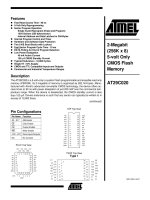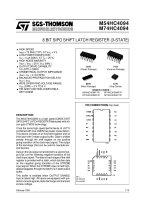Điện tử viễn thông ch49 khotailieu
Bạn đang xem bản rút gọn của tài liệu. Xem và tải ngay bản đầy đủ của tài liệu tại đây (132.82 KB, 10 trang )
Jeff P. Anderson, et. al.. "Permeability and Hysteresis Measurement."
Copyright 2000 CRC Press LLC. <>.
Permeability
and Hysteresis
Measurement
Jeff P. Anderson
LTV Steel Corporation
Richard J. Blotzer
LTV Steel Corporation
49.1
49.2
Definition of Permeability
Types of Material Magnetization
49.3
49.4
49.5
49.6
Definition of Hysteresis
Core Loss
Measurement Methods
Validity of Measurements
Diamagnetism • Paramagnetism • Ferromagnetism
Magnetic fields are typically conceptualized with so-called “flux lines” or “lines of force.” When such flux
lines encounter any sort of matter, an interaction takes place in which the number of flux lines is either
increased or decreased. The original magnetic field therefore becomes amplified or diminished in the
body of matter as a result of the interaction. This is true whether the matter is a typical “magnetic”
material, such as iron or nickel, or a so-called “nonmagnetic” material, such as copper or air.
The magnetic permeability of a substance is a numerical description of the extent to which that
substance interacts with an applied magnetic field. In other words, permeability refers to the degree to
which a substance can be magnetized.
Different substances possess varying degrees of magnetization. The aforementioned examples of
strongly magnetic materials have the ability to strengthen an applied magnetic field by a factor of several
thousand. Such highly magnetizable materials are called ferromagnetic. Certain other substances, such as
Al, only marginally increase an applied magnetic field. Such weakly magnetizable materials are called
paramagnetic. Still other substances, such as Cu and the rare gases, slightly weaken an applied magnetic
field. Such “negatively magnetizable” substances are called diamagnetic.
In common parlance, diamagnetic and paramagnetic substances are often called nonmagnetic. However, as detailed below, all substances are magnetic to some extent. Only empty space is truly nonmagnetic.
The term hysteresis has been used to describe many instances where an effect lags behind the cause.
However, Ewing was apparently the first to use the term in science [1] when he applied it to the particular
magnetic phenomenon displayed by ferromagnetic materials. Magnetic hysteresis occurs during the
cyclical magnetization of a ferromagnet. The magnetization path created while increasing an externally
applied field is not retraced on subsequent decrease (and even reversal) of the field. Some magnetization,
known as remanence, remains in the ferromagnet after the external field has been removed. This remanence, if appreciable, allows for the permanent magnetization observed in common bar magnets.
© 1999 by CRC Press LLC
TABLE 49.1 Conversion Factors Between the mks and cgs
Systems for Important Quantities in Magnetism
Quantity
H, applied field
B, flux density
M, magnetization
κ, susceptibility
mks
cgs
A/m
Wb/m2
Wb/m2
Wb/(A·m)
= 4π × 10–3 Oe
= 104 G
= 104/4π emu/cm3
= 16π2 × 10–7 emu/Oe·cm3
49.1 Definition of Permeability
Let an externally applied field be described by the vector quantity H. This field may be produced by a
solenoid or an electromagnet. Regardless of its source, H has units of ampere turns per meter (A m–1).
On passing through a body of interest, H magnetizes the body to a degree, M, formally defined as the
magnetic moment per unit volume. The units of M are usually webers per square meter. A secondary
coil (and associated electronics) is typically used to measure the combined effects of the applied field
and the body’s magnetization. This sum total flux-per-unit-area (flux density) is known as the induction,
B, which typically has units of Wb/m2, commonly refered to as a Tesla (T). Because H, M, and B are
usually parallel to one another, the vector notation can be dropped, so that:
B = µ0 H + M
(49.1)
where µ0 is the permeability of free space (4π × 10–7 Wb/A–1 m–1).
The absolute permeability, µ, of a magnetized body is defined as the induction achieved for a given
strength of applied field, or:
µ=
B
H
(49.2)
Often, the absolute permeability is normalized by µ0 to result in the relative permeability, µr (=µ/µ0).
This relative permeability is numerically equal and physically equivalent to the cgs version of permeability.
This, unfortunately, is still in common usage, and often expressed in units of gauss per oersted (G Oe–1),
although the cgs permeability is actually dimensionless. Conversion factors between the mks and cgs
systems are listed in Table 49.1 for the important quantities encountered.
49.2 Types of Material Magnetization
All substances fall into one of three magnetic groups: diamagnetic, paramagnetic, or ferromagnetic. Two
important subclasses, antiferromagnetic and ferrimagnetic, will not be included here. The interested
reader can find numerous discussions of these subclasses; for example, see [1].
Diamagnetism
Diamagnetic and paramagnetic (see next section) substances are usually characterized by their magnetic
susceptibility rather than permeability. Susceptibility is derived by combining Equations 49.1 and 49.2,
viz.
µr = 1 +
© 1999 by CRC Press LLC
M
κ
= 1+
µ0 H
µ0
(49.3)
FIGURE 49.1 For diamagnetic substances, magnetization M is small and opposite the applied field H as in this
schematic example for graphite (κ = –1.78 × 10–11 Wb A–1 m–1).
where κ is the susceptibility with units of Wb A–1 m–1. This so-called volume susceptibility is often converted
to a mass susceptibility (χ) or a molar susceptibility (χM). Values for the latter are readily available for
many pure substances and compounds [2]. Susceptibility is also often called “intrinsic permeability” [3].
In any atom, the orbiting and spinning electrons behave like tiny current loops. As with any charge
in motion, a magnetic moment is associated with each electron. The strength of the moment is typically
expressed in units of Bohr magnetons.
Diamagnetism represents the special case in which the moments contributed by all electrons cancel.
The atom as a whole possesses a net zero magnetic moment. An applied field, however, can induce a
moment in the diamagnetic material, and the induced moment opposes the applied field. The magnetization, M, in Equation 49.3 is therefore antiparallel to the applied field, H, and the susceptibility, κ, is
negative. For diamagnetic materials, µ < 1. Figure 49.1 shows a schematic M vs. H curve for graphite
with κ = –1.78 × 10–11 Wb A–1 m–1. Note that κ is a constant up to very high applied field values.
Paramagnetism
In a paramagnetic substance, the individual electronic moments do not cancel and the atom possesses
a net nonzero moment. In an applied field, the weak diamagnetic response is dominated by the atom’s
tendency to align its moment parallel with the applied field’s direction. Paramagnetic materials have
relatively small positive values for κ, and µ > 1.
Thermal energy retards a paramagnet’s ability to align with an applied field. Over a considerable range
of applied field and temperature, the paramagnetic susceptibility is constant. However, with very high
applied fields and low temperatures, a paramagnetic material can be made to approach saturation — the
condition of complete alignment with the field. This is illustrated in Figure 49.2 for potassium chromium
alum, a paramagnetic salt. Even at a temperature as low as 1.30 K, an applied field in excess of about
3.8 × 106 A m–1 is necessary to approach saturation. [Note in Figure 49.2, that 1 Bohr magneton = 9.27 ×
10–24 J T–1.]
© 1999 by CRC Press LLC
FIGURE 49.2 For paramagnetic substances, the susceptibility is constant over a wide range of applied field and
temperature. However, at very high H and low T, saturation can be approached, as in this example for potassium
chromium alum. (After W. E. Henry, Phys. Rev., 88, 559-562, 1952.)
Ferromagnetism
Ferromagnetic substances are actually a subclass of paramagnetic substances. In both cases, the individual
electronic moments do not cancel, and the atom has a net nonzero magnetic moment that tends to align
itself parallel to an applied field. However, a ferromagnet is much less affected by the randomizing action
of thermal energy compared to a paramagnet. This is because the individual atomic moments of a
ferromagnet are coupled in rigid parallelism, even in the absence of an applied field.
With no applied field, a demagnetized ferromagnet is comprised of several magnetic domains. Within
each domain, the individual atomic moments are parallel to one another, or coupled, and the domain
has a net nonzero magnetization. However, the direction of this magnetization is generally opposed by
a neighboring domain. The vector sum of all magnetizations among the domains is zero. This condition
is called the state of spontaneous magnetization.
With an increasing applied field, domains with favorable magnetization directions, relative to the
applied field direction, grow at the expense of the less favorably oriented domains. This process is
schematically illustrated in Figure 49.3. The exchange forces responsible for the ferromagnetic coupling
are explained by Heisenberg’s quantum mechanical model [4]. Above a critical temperature known as
the Curie point, the exchange forces disappear and the formerly ferromagnetic material behaves exactly
like a paramagnet.
During magnetization, ferromagnets show very different characteristics from diamagnets and paramagnets. Figure 49.4 is a so-called B–H curve for a typical soft ferromagnet. Note that B is no longer
© 1999 by CRC Press LLC
FIGURE 49.3 With no applied field (a) a ferromagnet assumes spontaneous magnetization. With an applied field
(b) domains favorably oriented with H grow at the expense of other domains.
FIGURE 49.4 Magnetization (B–H) curve for a typical soft ferromagnet. Permeability at point (H′, B′) is the slope
of the dashed line.
© 1999 by CRC Press LLC
linear with H except in the very low- and very high-field regions. Because of this, the permeability µ for
a ferromagnet must always be specified at a certain applied field, H, or, more commonly, a certain achieved
induction, B. Note that µ is the slope of the line connecting a point of interest on the B–H curve to the
origin. It is not the slope of the curve itself, although this value, dB/dH, is called the differential permeability [3].
Another ferromagnetic characteristic evident in Figure 49.4 is saturation. Once the applied field has
exceeded a certain (and relatively low) value, the slope of the magnetization curve assumes a constant
value of unity. At this point, M in Equation 49.1 has reached a maximum value, and the ferromagnet is
said to be saturated. For all practical purposes, all magnetic moments in the ferromagnet are aligned
with the applied field at saturation. This maximum magnetization is often called the saturation induction,
Bs [5]. Note that Bs is an intrinsic property — it does not include the applied field in its value.
49.3 Definition of Hysteresis
If H is decreased from HM in Figure 49.4, B does not follow the original magnetization path in reverse.
Even if H is repeatedly cycled from HM to –HM, B will follow a path on increasing H that is different
from decreasing H. The cyclical B–H relationship for a typical soft ferromagnet is displayed by the
hysteresis loops in Figure 49.5. Two loops are included: a minor loop inside a major loop generated by
independent measurements. The two differ in the value of maximum applied field: HM′ for the minor
loop was below saturation while HM″ for the major loop was near saturation. Both loops are symmetrical
about the origin as a point of inversion since in each case HM = Έ–HMΈ.
Notice for the minor loop that when the applied field is reduced from HM′ to 0, the induction does
not also decrease to zero. Instead, the induction assumes the value Br , known as the residual induction.
If the peak applied field exceeds the point of saturation, as for the major loop in Figure 49.5, Br assumes
a maximum value known as the retentivity, Brs .
Note that Br and Brs are short-lived quantities observable only during cyclical magnetization conditions.
When the applied field is removed, Br rapidly decays to a value Bd, known as the remanent induction. Bd
is a measure of the permanent magnetization of the ferromagnet. If the maximum applied field was in
excess of saturation, Brs rapidly decays to a maximum value of permanent magnetization, or remanence,
Bdm.
The minor loop in Figure 49.5 shows that in order to reduce the induction B to zero, a reverse applied
field, Hc , is needed. This is known as the coercive force. If the maximum applied field was in excess of
saturation, the coercive force assumes a maximum value, Hcs , known as the coercivity. Note that Hc and
Hcs are usually expressed as positive quantities, although they are negative fields relative to HM′ and HM″ .
The hysteresis loops in Figure 49.5 are known as dc loops. Typical sweep times for such loops range
from 10 s to 120 s. At faster sweep times, the coercivity will show a frequency dependence, as shown
experimentally in Figure 49.6. For soft magnetic materials, this dependence can be influenced by the
metallurgical condition of the ferromagnet [6].
49.4 Core Loss
During ac magnetization, some of the input energy is converted to heat in ferromagnetic materials. This
heat energy is called core loss and is classically comprised of three parts. The first, hysteresis loss, Ph, is
proportional to the ac frequency, f, and the area of the (slow-sweep) dc hysteresis loop:
∫
Ph = kf BdH
(49.4)
The second part is the loss due to eddy current formation, Pe . In magnetic testing of flat-rolled strips
(e.g., the Epstein test; see next section), this core loss component is classically expressed as
© 1999 by CRC Press LLC
FIGURE 49.5 Major and minor dc hysteresis loops for a typical soft ferromagnet. Labeled points of interest are
described in the text.
(πBft )
P =
2
e
where B
t
d
ρ
6dρ
(49.5)
= Peak induction
= Strip thickness
= Material density
= Material resistivity
The sum total Ph + Pe almost never equals the observed total core loss, Pt . The discrepancy chiefly
originates from the assumptions made in the derivation of Equation 49.5. To account for the additional
observed loss, an anomalous loss term, Pa , has often been included, so that
Pt = Ph + Pe + Pa
© 1999 by CRC Press LLC
(49.6)
FIGURE 49.6
TABLE 49.2
Commercially Available Instruments for Measurement of Permeability and Hysteresis
Manufacturer
LDJ
Troy, MI
(810) 528-2202
Lakeshore Cryotronics
Westerville, OH
(614) 891-2243
Donart Electronics
Pittsburgh, PA
(412) 796-5941
Soken/Magnetech
Racine, WI
(501) 922-6899
a
With increasing test frequency, coercivity for a soft ferromagnet also increases.
Model
Power
Material
typea
Ferromagnetic
type
Hysteresis
loop?
Core
loss?
Cost
($U.S.)
3500/5600
5500
VSM
VSM
Susceptometer
Magnetometer
3401
MS-2
ac/dc
dc
dc
dc
ac
dc
dc
ac
F
F
D, P, F
D, P, F
F
F
F
F
Soft & hard
Soft & hard
Soft & hard
Soft & hard
Soft & hard
Soft & hard
Soft
Soft
Y
Y
Y
Y
N
N
Y
N
Y
N
N
N
N
N
N
Y
30–90k
30–90k
50–110k
45–120k
50–110k
50–110k
20k+
20k+
DAC-BHW-2
ac
F
Soft
Y
Y
38k+
D — diamagnetic, P — paramagnetic, F — ferromagnetic.
49.5 Measurement Methods
Reference [3] is a good source for the various accepted test methods for permeability and hysteresis in
diamagnetic, paramagnetic, and ferromagnetic materials. Unfortunately, only a few of the instruments
described there are available commercially. Examples of these are listed in Table 49.2.
© 1999 by CRC Press LLC
The instruments in Table 49.2 include hysteresigraphs (LDJ models 3500, 5600, and 5500) and vibrating sample magnetometers (LDJ and Lakeshore Cryotronics VSM models). Also included are two Donart
models of Epstein testers. The Epstein test is commonly used to characterize flat-rolled soft ferromagnets
such as silicon electrical steels in sheet form. A recent alternative to the Epstein test is the single-sheet
test method. The Soken instrument in Table 49.2 is an example of such a tester. This method requires
much less sample volume than the Epstein test. It can also accommodate irregular sample geometries.
However, the Soken instrument is not yet accepted by the American Society for Testing and Materials
(ASTM) for reasons explained in the next section.
Note that all instruments in Table 49.2 can measure permeability (or susceptibility), but not all can
provide hysteresis loop measurements. Diamagnetic and paramagnetic materials generally require VSM
instruments unless one is prepared to construct their own specialty apparatus [3]. All instruments in
Table 49.2 can measure ferromagnetic materials, although only a few can accommodate hard (i.e., permanently magnetizable) ferromagnets.
The price ranges in Table 49.2 account for such options as temperature controls, specialized test
software, high-frequency capabilities, etc.
49.6 Validity of Measurements
For a ferromagnet under sinusoidal ac magnetization, the induction will show a waveform distortion
(i.e., B is nonsinusoidal) once Hm exceeds the knee of the B–H curve in Figure 49.4. Brailsford [7] has
discussed such waveform distortion in detail. With one exception, all ac instruments in Table 49.2
determine H from its sinusoidal waveform and B from its distorted waveform.
The single exception is the Soken instrument. Here, feedback amplification is employed to deliberately
distort the H waveform in a way necessary to force a sinusoidal B waveform. In general, this will result
in a smaller measured value for permeability compared to the case where feedback amplification is not
used. Some suggest this to be the more precise method for permeability measurement, but the use of
feedback amplification has prevented instruments such as the Soken from achieving ASTM acceptance
to date.
Defining Terms
Permeability: The extent to which a material can be magnetized
Hysteresis: A ferromagnetic phenomenon in which the magnetic induction B is out of phase with the
magnetic driving force H.
References
1.
2.
3.
4.
5.
6.
B. D. Cullity, Introduction to Magnetic Materials, Reading, MA: Addison-Wesley, 1972.
D. R. Lide (ed.), CRC Handbook of Chemistry and Physics, Boca Raton, FL: CRC Press, 1992-3.
Anonymous, 1995 Annual Book of ASTM Standards, Philadelphia, PA: ASTM, 3.04, 1995.
C. Kittel, Introduction to Solid State Physics, 5th ed., New York: John Wiley & Sons, 1976.
Page 11 of Ref. [3].
R. Thomas and G. Morgan, Proc. Eleventh Ann. Conf. on Properties and Applications of Magnetic
Materials, Chicago, 1992.
7. F. Brailsford, Magnetic Materials, 3rd ed., London: Metuen and New York: Wiley, 1960.
© 1999 by CRC Press LLC









